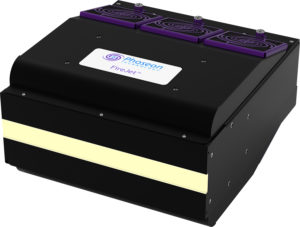Ultraviolet () curing technology is utilised for drying coatings and other UV-sensitive materials through polymerisation. UV light emitting diode improves on that existing process by enabling thinner, heat-sensitive substrates, while reducing harmful byproducts such as ozone and improving workplace safety. Additionally, UV LEDs can be turned on and off instantly, utilising input power efficiently to enable lower operation costs over the application lifetime.
TECHNOLOGY
As UV LED curing technology continues to gain worldwide adoption, it is import ant to keep in mind some of the important key features that build a robust product optimised for high performance and long lifetime. There are many product options on the market for UV LED but not all of them are built to support rugged and industrial environment s.
Reliability is very important for UV curing so make sure to find a supplier that does highly accelerated life testing (HALT) to confirm the products are proven to be reliable. In addition, product engineering is also an important key feature when selecting a UV LED supplier.
Confronted with such exciting and rapidly evolving technology, system builders and end users are closely monitoring the ever-changing UV LED curing landscape.
Light emitting diodes
Not all LEDs are built the same nor do they exhibit the same characteristics. UV LED lamp suppliers have critical choices to make as to the quality, type, material and shape of LED for their systems. Key LED characteristics considered by each UV LED lamp supplier include wavelength and UV output.
Some LED manufacturers only sell their LEDs pre-packaged into arrays or assemblies that they feel maximise the UV output. UV LED lamp system suppliers that purchase pre-packaged arrays have typically made a tradeoff between faster time-t o-market and less differentiated lamps versus a slightly longer time-to-market and maximising UV power. This is an area where UV LED lamp suppliers can differentiate themselves based on the suppliers’ architecture and engineering capability where two suppliers can take the same batch of LEDs and achieve very different performance in the end product.
Optics
UV LED optics are one of the most important differentiator s in UV light sources. The science of optically improving the LEDs to maximise their UV output is key to the lamp’s final capability. Based on the end application, the optical engineer has to decide what shape, form and material best utilises the LED’s unique characteristics . Next they have to balance the fact the LEDs are a ‘flood’ type of light, unlike a focused mercury lamp where the light is captured by a reflector and directed to a specific point, focal length.
The optical engineer is challenged to use methods to ensure the maximum amount of light ‘escapes’ at the desired irradiance through the window/ glass towards the material. LED Lamp suppliers have used various, confidential methods to maximise the UV LED light.
While an end-user or OEM should not necessarily be concerned with how the optics are provided in the UV LED lamp , they should understand if the supplier has the ability to improve their design for their specific application need s.
UV IRRADIANCE
UV output continues to improve every year, opening the door to new high-performance applications. Water-cooled UV LED curing products are now available on the market with 12W/cm² peak irradiance at 365nm wavelength. Scalable air-cooled products are available at 8W/cm² peak irradiance at 365nm wavelength. These high-performance products are ideally suited for curing adhesives and coatings where 365nm is the specified wavelength. The high peak intensity increases application performance and throughput to levels that were not previously possible.
Tags: Asia Pacific Coatings Journal | UV LED Technology | UV LED Industrial CuringCategories: Adhesives | Coatings | Corporate | Inks | Manufacturing | Printing, Digital | Wood
